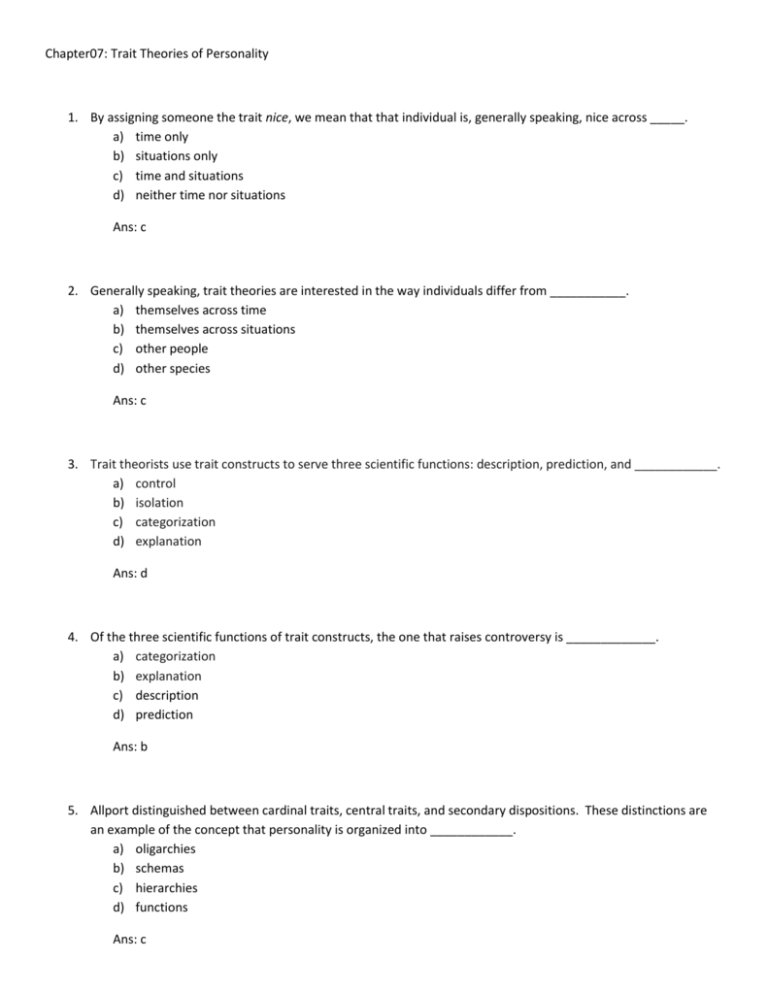Chapter07: Trait Theories of Personality By assigning someone the
advertisement

Chapter07: Trait Theories of Personality 1. By assigning someone the trait nice, we mean that that individual is, generally speaking, nice across _____. a) time only b) situations only c) time and situations d) neither time nor situations Ans: c 2. Generally speaking, trait theories are interested in the way individuals differ from ___________. a) themselves across time b) themselves across situations c) other people d) other species Ans: c 3. Trait theorists use trait constructs to serve three scientific functions: description, prediction, and ____________. a) control b) isolation c) categorization d) explanation Ans: d 4. Of the three scientific functions of trait constructs, the one that raises controversy is _____________. a) categorization b) explanation c) description d) prediction Ans: b 5. Allport distinguished between cardinal traits, central traits, and secondary dispositions. These distinctions are an example of the concept that personality is organized into ____________. a) oligarchies b) schemas c) hierarchies d) functions Ans: c 6. Allport is unique amongst trait theorists because he endorses a(n) ________ to measurement, whereas they tend to favor ___________ approaches. a) idiographic; experimental b) idiographic; nomothetic c) nomothetic; experimental d) nomothetic; idiographic Ans: b 7. Psychologists use a statistical tool called factor analysis to help them to_________________. a) identify a basic set of traits that succinctly describes the major ways in which people differ b) identify a small number of factors that summarize the intercorrelations among a large number of traits c) reduce the thousands of traits needed to describe personality into a more manageable set d) all of the above Ans: d 8. Though factor analysis can identify the factors, it is up to the therapist to interpret them. This suggests that the factors are _________. a) ambiguous b) unimportant c) unscientific d) unambiguous Ans: a 9. In Cattell’s theory, emotional stability is an example of a __________ trait, whereas intelligence is an example of a ___________ trait. a) temperament; ability b) temperament; dynamic c) ability; temperament d) ability; dynamic Ans: a 10. Cattell turned to investigations that made use of OT-data out of concern for __________, a potential problem in using self-report data. a) self-deception b) tempermentality c) emotional stability d) cardinality Ans: a 11. Cattell came up with the concepts of ______ and ______ to account for the fact that people’s behavior is dynamic. a) sources; roles b) states; roles c) states; schemas d) sources; schemas Ans: b 12. Eysenck recognized that trait theory can break out of the circularity of its reasoning by going beyond the mere use of words and identifying __________systems that correspond to traits. a) tautological b) environmental c) seriological d) biological Ans: d 13. Eysenck used ___________ factor analysis to identify “superfactors.” a) primary b) secondary c) tertiary d) hierarchical Ans: b 14. Before he added a third superfactor, Eysenck’s analyses identified two superfactors: extroversion/introversion and _________________. a) psychoticism b) neuroticism c) sanguineness d) melancholy Ans: b 15. Eysenck’s lemon drop test was an OT-data procedure designed to distinguish ____________ from ___________. a) neurotics from calm people b) neurotics from extroverts c) introverts from extroverts d) introverts from calm people Ans: c 16. The fact that the dimension of introversion-extraversion is found cross-culturally supports Eysenck’s theorizing about the ___________ basis of traits. a) tautological b) environmental c) seriological d) biological Ans: d 17. Unfortunately for Eysenckian theory, research has not consistently supported his physiological theory of _________. a) neuroticism b) psychoticism c) extroversion d) introversion Ans: a 18. Which of the following is not true of the distinction between introverts and extroverts? a) Introverts do better in school than do extraverts b) Introverts prefer for vocations involving interactions with other people c) Extraverts enjoy explicit sexual and aggressive humor more than do introverts d) Extraverts are more active sexually, in terms of frequency and different partners, than introverts. Ans: b 19. In spite of his focus on the biological bases of traits, Eysenck was __________ individuals’ capacity to change. a) pessimistic about b) flustered by c) optimistic about d) uninterested in Ans: c







